An Intel Core i9 11900K CPU on a Maximus XIII Apex motherboard from Asus is used as the test platform. The CPU is not manually overclocked for this and only the Adaptive Boost Technology is activated to achieve the highest possible clock rates in all situations. The cache clock is statically increased to 4.5 GHz to ensure the best possible connection to the main memory. The BIOS version used is 0903, which is the latest at the time of testing.
But I also didn’t want to pass up the chance to take our AMD Ryzen platform for a spin with a 5950X CPU on a Gigabyte B550 Aorus Pro v2 motherboard, which is best suited for high RAM clock speeds with its optimized daisy chain 4-DIMM layout. The CPU is operated with Precision Boost Overdrive and an Infinity Fabric clock of 1900 MHz. The BIOS version used is F13k, which is the latest at the time of testing.
As always, a complete listing of the hardware used follows here:
| Test systems | |
|---|---|
| Hardware: |
Intel platform
AMD platform
|
| Cooling: |
|
| Housing: |
|
| Periphery: |
|
| Measuring devices |
|
In order to be able to put the performance of the RAM kit into relation, the tests on the Intel platform are also carried out with a manually overclocked single-rank B-Die kit. The control sample or “Control Kit” used for this purpose bears the product number F4-4000C15D-16GVK and also comes from G.Skill. The tested clock rates represent the maximum overclocs that could be achieved with the used hardware in the time frame of the review and reproducibly tested as stable. Besides the XMP profile with DDR4-5066, I of course wanted to overclock the kit with the goal of stabilizing DDR4-5333 or maybe even DDR4-5600. Unfortunately, I encountered problems that could not be solved even with considerable time expenditure and which I would like to explain briefly in the following.
With 1.65 V RAM voltage, just mentioned clock rates can be booted without problems, even when the timings are tightened. Contrary to my expectations, looser timings do not lead to higher clock rates or more stability, rather the opposite. As you can see in the two screenshots above, the configuration with DDR4-5333 with timings 20-27-27-46 is stable, but only once or until the next boot or memory training. If the system is rebooted “cold” and thus performs a new memory training, the kit may not survive a minute in the TM5 without errors. BIOS settings have not been changed in the meantime, RTTs are the same and the DIMM temperature is also identical except for about 3 °C.
In my mind, the only possible explanation for the inconsistent behavior is a possible bug in the BIOS or microcode that is responsible for the memory training. So it is currently not possible for me to stabilize clock rates above DDR4-5066 reproducible. This doesn’t stop us from coaxing more performance out of the kit by tightening up the timings though. The mentioned primary timings 20-27-27-46 are now applied to the clock rate DDR4-5066 and then the remaining timings are tightened.
Here comes another limitation, caused by the silicon quality of the integrated memory controller (IMC) of the CPU. So both of my i9 CPUs seem to generally clock higher in the Gear 1, while being less stable at high clock speeds in the Gear 2. On the other hand, my i7 CPU is limited to DDR4-3733 in Gear 1, but can run tighter timings stably at the same clock speeds in Gear 2. Whether there is a general interaction between the stability in the gears per CPU can of course not be determined based on 3 CPUs.
As a consequence, the better of the two i9 CPUs also becomes unstable if you tighten, say, the secondary timings tRRD_S or _L or tertiary timings on DDR4-5066. However, since the i9 CPU performs better in benchmarks due to its higher core clock alone and also allows higher clock rates in Gear 1, the complete manual overclocking only makes it into the screenshot above. All tested configurations were operated only with manually set primary timings, tRFC, tREFI and tRC, at 1.6 V. The RAM kit can definitely do more, it’s just that my combination of CPU and motherboard can’t get it stable, at least currently.
In terms of voltages on the Intel platform, IO Mem are set to 1.55 V, SA to 1.4 V in Gear 2 and 1.6 V in Gear1. On the AMD platform, 1.2 V SOC, 1.1 V VDDG IOD and 1.0 V VDDG CCD are used. In the following gallery I have all configurations with all their timings set or left on auto for you to browse through:
















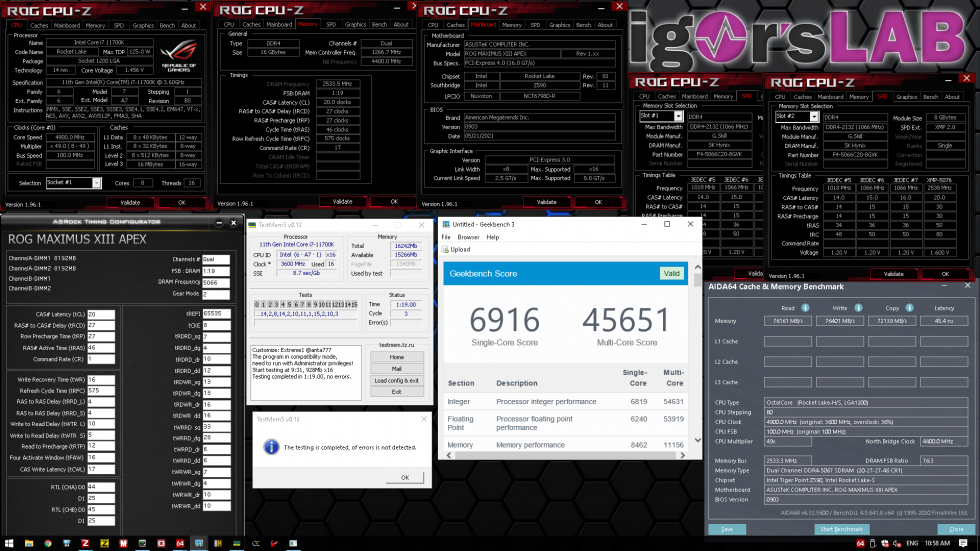
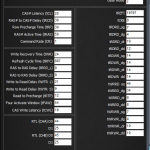
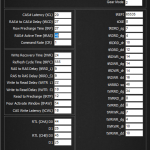
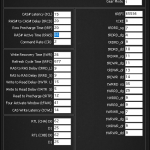
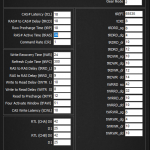
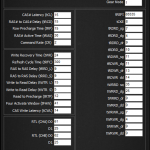
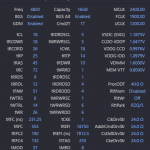
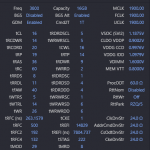

















10 Antworten
Kommentar
Lade neue Kommentare
Mitglied
Mitglied
Urgestein
Veteran
Urgestein
Mitglied
Mitglied
Veteran
Alle Kommentare lesen unter igor´sLAB Community →